新概念英语第一册第5课
新概念英语第一册(Lesson5)课文及学习笔记-全

新概念英语第一册(Lesson5)课文及学习笔记-全新概念英语| 第一册(Lesson 5)课文及学习笔记【课文内容及译文】Lesson 5 Nice to meet you很高兴见到你。
Listen to the tape then answer this question.Is Chang-woo Chinese?MR. BLAKE: Good morning.STUDENTS: Good morning, Mr. Blake.MR. BLAKE: This is Miss Sophie Dupont.Sophie is a new student. She is French.MR. BLAKE: Sophie, this is Hans. He is German.HANS: Nice to meet you.MR. BLAKE: And this is Naoko. She's Japanese.NAOKO: Nice to meet you.MR. BLAKE: And this is Chang-woo. He's Korean.CHANG-WOO: Nice to meet you.MR. BLAKE: And this is Luming. He is Chinese. LUMNG: Nice to meet you.MR. BLAKE: And this is Xiaohui. She's Chinese, too. XIAOHUI: Nice to meet you.布莱克先生:早上好。
学生:早上好,布莱克先生。
布莱克先生:这位是索菲娅.杜邦小姐。
索菲娅是个新学生。
她是法国人。
布莱克先生:索菲娅,这位是汉斯。
他是德国人。
汉斯:很高兴见到你。
布莱克先生:这位是直子。
她是日本人。
直子:很高兴见到你。
布莱克先生:这位是昌宇。
他是韩国人。
昌宇:很高兴见到你。
新概念英语 第5课 no wrong numbers
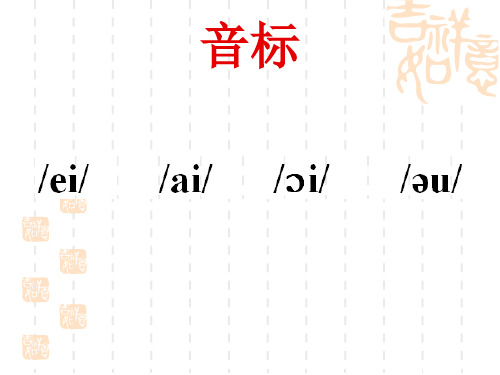
Pinhurst is only five miles from Silbury
介词from在这里表示距离上相 隔, “距……”、“离……” , 常与away连用
It is far (away) from here. Bus stop is only one mile (away) from school/here.
distance n. 距离 keep somebody at a distance (对某人)保持疏远
request n.要求, 请求 request for 对……有请求, 有需 求 I have a request for the cake.
spare adj. 多余的,空闲的 a spare bedroom 空着的卧室 spare time 业余时间
The other表示“两者中的另一 个”;“the other+复数可数名词” 表示“其他的……”;the others 表示“其他的人或物”。Others 及“other+复数名词”泛指“其他 的人或物”。这些词语在句中可做 主语,宾语和定语。
He got two books: one is a textbook, the other is a novel.
This coat is too dark. Please show me another. (宾语)
Please give another book. (定 语)
another+数词+可数名词复数时, 意为“再,又”
Please give me another ten minutes. 请再给我10分钟。
5. in a way, 在某种意义上,在某种程度上
In a way, it is an important book.
新概念英语第一册课文1到课文15及译文
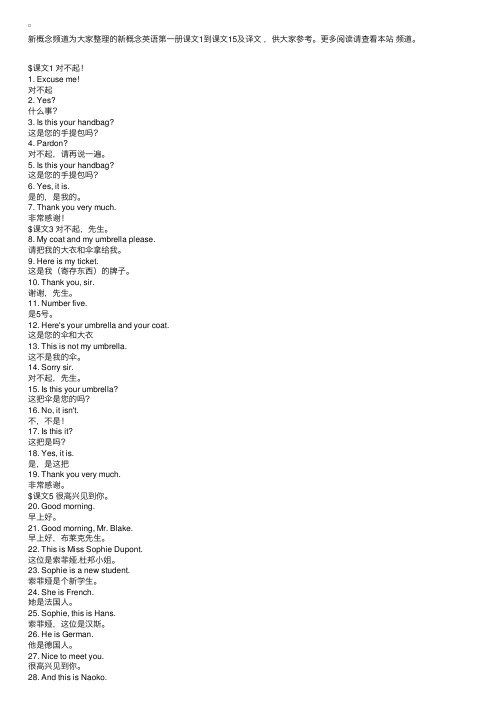
新概念频道为⼤家整理的新概念英语第⼀册课⽂1到课⽂15及译⽂,供⼤家参考。
更多阅读请查看本站频道。
$课⽂1 对不起!1. Excuse me!对不起2. Yes?什么事?3. Is this your handbag?这是您的⼿提包吗?4. Pardon?对不起,请再说⼀遍。
5. Is this your handbag?这是您的⼿提包吗?6. Yes, it is.是的,是我的。
7. Thank you very much.⾮常感谢!$课⽂3 对不起,先⽣。
8. My coat and my umbrella please.请把我的⼤⾐和伞拿给我。
9. Here is my ticket.这是我(寄存东西)的牌⼦。
10. Thank you, sir.谢谢,先⽣。
11. Number five.是5号。
12. Here's your umbrella and your coat.这是您的伞和⼤⾐13. This is not my umbrella.这不是我的伞。
14. Sorry sir.对不起,先⽣。
15. Is this your umbrella?这把伞是您的吗?16. No, it isn't.不,不是!17. Is this it?这把是吗?18. Yes, it is.是,是这把19. Thank you very much.⾮常感谢。
$课⽂5 很⾼兴见到你。
20. Good morning.早上好。
21. Good morning, Mr. Blake.早上好,布莱克先⽣。
22. This is Miss Sophie Dupont.这位是索菲娅.杜邦⼩姐。
23. Sophie is a new student.索菲娅是个新学⽣。
24. She is French.她是法国⼈。
25. Sophie, this is Hans.索菲娅,这位是汉斯。
26. He is German.他是德国⼈。
新概念英语第一册课文(全中文)
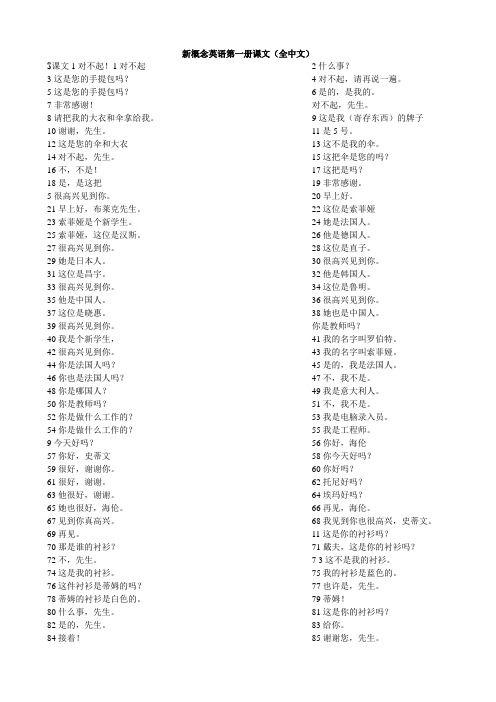
新概念英语第一册课文(全中文)$课文1对不起!1对不起2什么事?3这是您的手提包吗?4对不起,请再说一遍。
5这是您的手提包吗?6是的,是我的。
7非常感谢!对不起,先生。
8请把我的大衣和伞拿给我。
9这是我(寄存东西)的牌子10谢谢,先生。
11是5号。
12这是您的伞和大衣13这不是我的伞。
14对不起,先生。
15这把伞是您的吗?16不,不是!17这把是吗?18是,是这把19非常感谢。
5很高兴见到你。
20早上好。
21早上好,布莱克先生。
22这位是索菲娅23索菲娅是个新学生。
24她是法国人。
25索菲娅,这位是汉斯。
26他是德国人。
27很高兴见到你。
28这位是直子。
29她是日本人。
30很高兴见到你。
31这位是昌宇。
32他是韩国人。
33很高兴见到你。
34这位是鲁明。
35他是中国人。
36很高兴见到你。
37这位是晓惠。
38她也是中国人。
39很高兴见到你。
你是教师吗?40我是个新学生,41我的名字叫罗伯特。
42很高兴见到你。
43我的名字叫索菲娅。
44你是法国人吗?45是的,我是法国人。
46你也是法国人吗?47不,我不是。
48你是哪国人?49我是意大利人。
50你是教师吗?51不,我不是。
52你是做什么工作的?53我是电脑录入员。
54你是做什么工作的?55我是工程师。
9今天好吗?56你好,海伦57你好,史蒂文58你今天好吗?59很好,谢谢你。
60你好吗?61很好,谢谢。
62托尼好吗?63他很好,谢谢。
64埃玛好吗?65她也很好,海伦。
66再见,海伦。
67见到你真高兴。
68我见到你也很高兴,史蒂文。
69再见。
11这是你的衬衫吗?70那是谁的衬衫?71戴夫,这是你的衬衫吗?72不,先生。
7 3这不是我的衬衫。
74这是我的衬衫。
75我的衬衫是蓝色的。
76这件衬衫是蒂姆的吗?77也许是,先生。
78蒂姆的衬衫是白色的。
79蒂姆!80什么事,先生。
81这是你的衬衫吗?82是的,先生。
83给你。
84接着!85谢谢您,先生。
$课文13一件新连衣裙86你的新连衣裙是什么颜色的?87是绿色的。
新概念英语第一册课文1-143
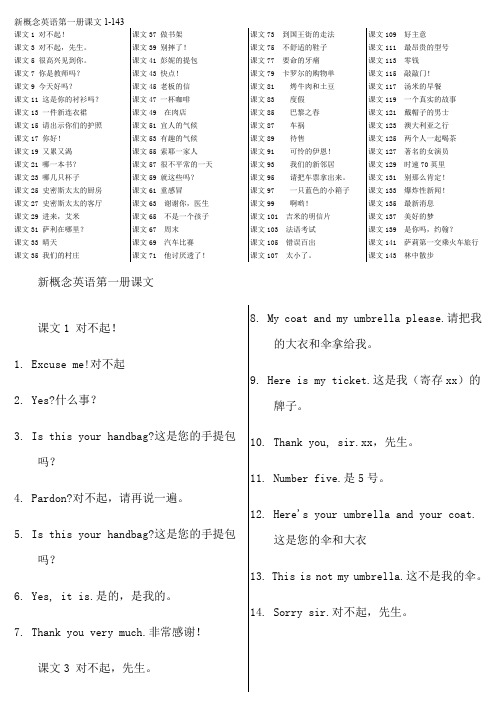
课文1 对不起!课文3 对不起,先生。
课文5 很高兴见到你。
课文7 你是教师吗?课文9 今天好吗?课文11 这是你的衬衫吗?课文13 一件新连衣裙课文15 请出示你们的护照课文17 你好!课文19 又累又渴课文21 哪一本书?课文23 哪几只杯子课文25 史密斯太太的厨房课文27 史密斯太太的客厅课文29 进来,艾米课文31 萨利在哪里?课文33 晴天课文35 我们的村庄课文37 做书架课文39 别摔了!课文41 彭妮的提包课文43 快点!课文45 老板的信课文47 一杯咖啡课文49 在肉店课文51 宜人的气候课文53 有趣的气候课文55 索耶一家人课文57 很不平常的一天课文59 就这些吗?课文61 重感冒课文63 谢谢你,医生课文65 不是一个孩子课文67 周末课文69 汽车比赛课文71 他讨厌透了!课文73 到国王街的走法课文75 不舒适的鞋子课文77 要命的牙痛课文79 卡罗尔的购物单课文81 烤牛肉和土豆课文83 度假课文85 巴黎之春课文87 车祸课文89 待售课文91 可怜的伊恩!课文93 我们的新邻居课文95 请把车票拿出来。
课文97 一只蓝色的小箱子课文99 啊哟!课文101 吉米的明信片课文103 法语考试课文105 错误百出课文107 太小了。
课文109 好主意课文111 最昂贵的型号课文113 零钱课文115 敲敲门!课文117 汤米的早餐课文119 一个真实的故事课文121 戴帽子的男士课文123 澳大利亚之行课文125 两个人一起喝茶课文127 著名的女演员课文129 时速70英里课文131 别那么肯定!课文133 爆炸性新闻!课文135 最新消息课文137 美好的梦课文139 是你吗,约翰?课文141 萨莉第一交乘火车旅行课文143 林中散步新概念英语第一册课文课文1 对不起!1. Excuse me!对不起2. Yes?什么事?3. Is this your handbag?这是您的手提包吗?4. Pardon?对不起,请再说一遍。
新概念英语第一册第五课教案+练习知识讲解

四. Write these with short forms : Here is your pen .Here’s your pen . 1.It is not American . 2.It is English . 3.He is Italian . 4.She is not Japanese . 5.That is a teacher . 6.He is not French . 7.She is German .
瑞典的 法国的
德国的 日本的
韩国的 英国的
美国的 意大利的
如何询问汽车的品牌呢?
• What make is the car ? • It’s a German car .
• What make is his / her / your car ? • It’s a American car .
Sophie is a new student .
She is French
a 一个,一辆 ,一只… 例如 a car
表示一个还可以用 an,例如 an apple
a 与 an 在英语被称为不定冠词,二者在意义上没 有区别,但是,在发音以辅音音素开头的词前用a; 在发音以元音音素开头的词前用an。
And this is Luming. He’s Chinese .
“Nice to meet you .”
And this is Xiaohui . She’s Chinese , too .
“Nice to meet you .”
二. Translate the following into chinese:
用于初次与他人见面等非正式场合。对方的回应一般应为: Nice to meet you,too(我也很高兴见到你)。
新概念英语第一册(1-14课)单词
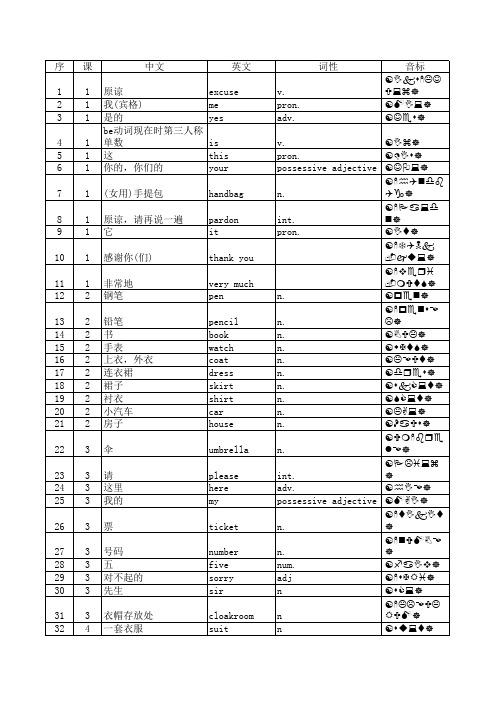
英文 excuse me yes be动词现在时第三人称单数 is 这 this 你的,你们的 your (女用)手提包 handbag 原谅,请再说一遍 pardon 它 it 感谢你(们) thank you 非常地 very much 钢笔 pen 铅笔 pencil 书 book 手表 watch 上衣,外衣 coat 连衣裙 dress 裙子 skirt 衬衣 shirt 小汽车 car 房子 house 伞 umbrella 请 please 这里 here 我的 my 票 ticket 号码 number 五 five 对不起的 sorry 先生 sir 衣帽存放处 cloakroom 一套衣服 suit 学校 school 老师 teacher 儿子 son 女儿 daughter 先生 Mr. 好 good 早晨 morning 小姐 Miss 新的 new 学生 student 法国人 French 德国人 German 原谅 我(宾格) 是的
ks'KJU:z]
hQndbQg] Pa:dn]
TQNk-ju:] veri-mVtS]
pensEL]
m'brelE]
tIkIt] nVMBE]
KLEUKRUM]
ti:tSE]
dO:tE]
MO:nIN]
tju:dEnt] rentS] dZC:MEn]
ZQpE'ni:z] E'RIEn] ,tSaI'ni:z]
中文
词性 v. pron. adv. v. pron. possessive adjective n. int. pron.
音标 [Iks'KJU:z] [MI:] [Jes] [Iz] [DIs] [JO:] ['hQndbQg] ['Pa:dn] [It] ['TQNk-ju:] ['veri-mVtS] n. [pen] n. ['pensEL] n. [BUK] n. [wXtS] n. [KEUt] n. [dres] n. [skC:t] n. [SC:t] n. [KA:] n. [HaUs] n. [Vm'brelE] int. [PLi:z] adv. [hIE] possessive adjective [MAI] n. ['tIkIt] n. ['nVMBE] num. [faIv] adj ['sXRi] n [sC:] n ['KLEUKRUM] n [su:t] n [sku:l] n ['ti:tSE] n [sVn] n ['dO:tE] ['MIstE] adj [GUd] n ['MO:nIN] [mIs] adj. [nju:] n ['stju:dEnt] adj&n. [frentS] adj&n. ['dZC:MEn]
新概念英语第一册第5课Lesson5课文单词知识点

Lesson5MR. BLAKE: Good morning.STUDENTS: Good morning, Mr. Blake. MR. BLAKE: This is Miss Sophie Dupont. Sophie is a new student. She is French.MR. BLAKE: Sophie, this is Hans. He is German.HANS: Nice to meet you.MR. BLAKE: And this is Naoko. She's Japanese.NAOKO: Nice to meet you.MR. BLAKE: And this is Chang-woo. He's Korean.CHANG-WOO: Nice to meet you. MR. BLAKE: And this is Luming. He is Chinese.LUMNG: Nice to meet you.MR. BLAKE: And this is Xiaohui.She's Chinese, too.XIAOHUI: Nice to meet you.布莱克先生:早上好。
学 生:早上好,布莱克先生。
布莱克先生:这位是索菲娅·杜邦小姐。
索菲娅是个新学生。
她是法国人。
布莱克先生:索菲娅,这位是汉斯。
他是德国人。
汉 斯:很高兴见到你。
布莱克先生:这位是直子。
她是日本人。
直 子:很高兴见到你。
布莱克先生:这位是昌宇。
他是韩国人。
昌 宇:很高兴见到你。
布莱克先生:这位是鲁明。
他是中国人。
鲁 明:很高兴见到你。
布莱克先生:这位是晓惠。
她也是中国人。
晓 惠:很高兴见到你。
【知识点讲解】1. 今天我们会学习到很多打招呼的方法,这在实际交往中很有用哦!1)Good morning. 早上好。
2) Good afternoon. 下午好。
[全]新概念英语(第1册5课)
![[全]新概念英语(第1册5课)](https://img.taocdn.com/s3/m/20784edca300a6c30c229fd5.png)
新概念英语(第1册5课)新概念英语第一册Lesson 5 New words & expressions1. Mr. ['mistə] 先生2. good [gud] a.好3. morning ['mɔ:niŋ] n.早晨4. Miss [mis] 小姐5. new [nju:] a.新的6. student ['stju:dənt] n.学生7. French [frentʃ] a.& n.法国人8. German ['dʒə:mən] a.& n.德国人9. nice ['nais] a.美好的10. meet [mi:t] v.遇见11. Japanese [ˌdʒæpə'ni:z] a.& n.日本人12. Korean [kə'riən] a.& n.韩国人13. Chinese [ˌtʃai'ni:z] a.& n.中国人14. too [tu:] ad.也1. Mr. ['mistə] 先生Mr,a title used before the family name or full name of a man who has no other title, orwhen talking to a man who holds a particularofficial position(用在男子的姓、姓名或职务之前)先生Mr Jones/Mr Wang/Mr David Jones 琼斯先生/王先生/戴维琼斯先生Good afternoon, Mr Dawson.下午好,道森先生。
We're looking for a Mr (= a man called) George Smith.我们在找一位名叫乔治史密斯的先生。
It's an honour to have you here today, Mr President.很荣幸您今天能来,总统先生。
新概念英语第一册1-5课
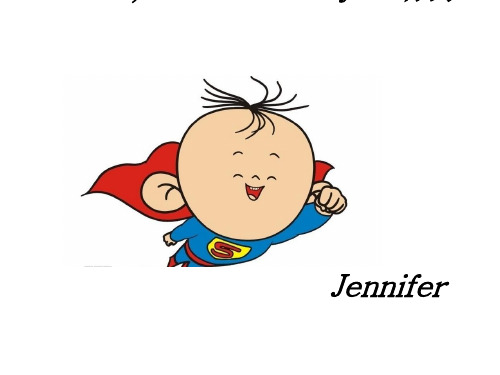
Thank you ,sir .
Number five . ?
Here’s your umbrella and your coat .
Here’s缩写 = here is(正式场合) 写出Here is my ticket.的缩写形式。
This is not myumbrella .
num.一 num.二 num.三 num.四 num.五 num.六 num.七 num.八 num.九 num.十
Watch and Read
一. Fill in the blanks:
Give me my coat and umbrella
My coat and mpylueamsebrella please!
No ,it isn’t .
???
Is this It ? It 指代umbrella,避免重 复 Yes,it is .
Thank you very much .
Lesson 5
Nice to meet you.
练一练
1. Excuse __B__ ! Is this your hamdbag?
National Flag
五. Write the questions with the words:
Is this your handbag ? Yes, it is./No, it isn’t. It isn’t my handbag .
pen pencil book watch
coat
dress shirt skirt car house
宾格
me us you you him her it them
所有格形容词
新概念英语单词第一册第5课:很高兴见到你

新概念英语单词第一册第5课:很高兴见到你Mr. ['mist(r)] n.先生good [gd] adj.好的【派生词】goodbye再见 goodness善良【反义词】bad坏的 weak差的【单词搭配】as good as和……一样好 do sb.good对某人有好处【单词例句】A:Do you know Bill?A:你理解比尔吗?B:Yes, he is my good friend.B:理解,他是我的好朋友。
morning ['mn] 早晨【扩充词汇】cockcrow黎明 dawn黎明【单词搭配】in the moming茌早上【单词例句】A: Take the pills twice a day, once in the moming and once in the evening.A:这些药每天服两次,早晚各服一次。
B:How many pills shouldI take each time?B:每次服几粒?Miss[mis] 小姐【单词例句】A: Karl, have you met my colleague, Miss Li?A:卡尔,你见过我的同事李小姐了吗?B: No,I haven't had the pleasure yet.B:没有,我至今还没有这个荣幸。
new [nju]adj.【派生词】news新闻,新的 newcomer新来者【义词】old老的,旧的【单词搭配】new coat新衣服 New York纽约【单词例句】A: CanI borrow your new bicycle, John?A:约翰,我能借你的新自行车用一下吗?B:Sure,here is the key.B:当然能够,给你钥匙。
student ['stjud()nt]学生【单词扩充】pupil小学生 undergraduate大学生【单词搭配】student union学生会【单词例句】A: How many students are there in your classroom? A:你们班上有多少学生?B: There are more than sixtyB:有六十多个。
新概念英语第一册第5课_课件

五. Chant :
宾格代词顺口溜: The end !
我是me,你是You ;
男他him ,女她her ,动物的它是 It;
我们us ,你们You ,他们them.
Homework 1.一课一练5,6课 2.课单词背写,准备听写 3.背诵第5课课文。
[ɔ]
闭音节中的o
job clock long song shop stop lost got boss hot
a 发[ɔ]的 watch water
句子
1. She lost that job, but she got this job.
2. The clock often stops. 3. The boss lost a clock
Chinese---China French---France
France
eg. I come from France. I’m from France. 我来自法国。
German---Germany
---Are you a _____ (德国人)? ---Yes, I am. eg. He can speak _____
ቤተ መጻሕፍቲ ባይዱ
nice 同义词good
eg. You are a nice boy. It’s a nice day. It’s a nice food.
meet 同音词meat
非正式问候---Nice to meet you.
--- Nice to meet
you, too.
正式问候 --- How do you do?
She is (a) French.
美好的 nice 见到你很高兴。 Nice to meet you. 遇见 meet
新概念第一册英语lesson5-6
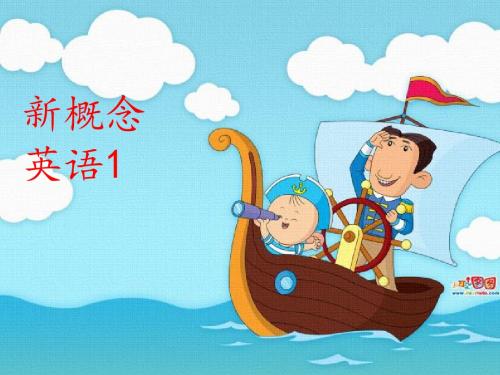
1 问候语 2 Mr. sir用法 3 介绍某人This is``` 4 国人表达法:主语 +be+国籍 5 很高兴见到你的几种 表达方式 7课文背诵
Lesson 6
What make is it?
Swedish
瑞典的;瑞 典人 Sweden 瑞典
English 英国的;英国人 England 英国
Mr. sir用法
Mr.用于男士的姓之前, 不能单独用. E.g.: Mr. Blake. sir 一般单独使用,是对长 者、上司或男顾客的尊 称 E.g. Sorry, sir. 对不起,先生。
三介绍他人 这是索菲亚 · 杜邦小姐。 This is 〈Miss Sopphie Dopont〉. 主语 系动词 表语
And this is Luming. He’s _________ Chinese. .
“Nice to meet you .”
“Nice to meet you .”
And this is Xiaohui . She’s Chinese , ______. too
看图片背
课堂总结
Xiaohui
昌宇
晓惠
课文提问
A story about a new student. Listen and answer 1 How many students are there? 2 Is Sophie German? 3 Is Hans French? translate 4 What nationality is Naoko? 5 What nationality is Chang-woo? 6 Where does Luming come from? 7 What’s the name of the Chinese girl? Listen again and translate.(close the books)
新概念英语第一册Lesson5课件
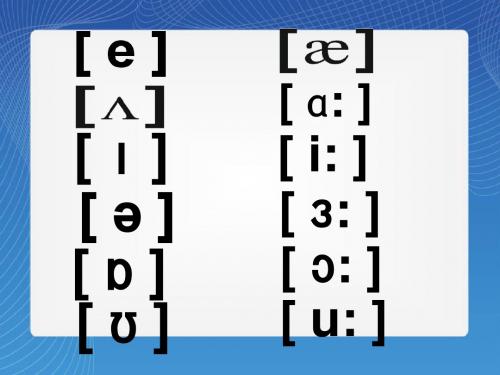
your
his
her
its
our
your
their
名词 性物 mine 主代 词
yours his hers
its ours yours theirs
my • 1. This is not _________ kite. This kite is very small,mine but _________ is very big. ( I )
She's Japanese.
Chang-woo
He's Korean.
Luming
He's Chinese.
Xiaohui
She's Chinese, too.
French
German
Japanese
Korean
Chinese
Chinese
Mr. /'mistə/ 先生 Miss /mɪs/ 小姐 good /gud/ 好的 morning /'mɔ:niŋ/ 早上 afternoon 下午 evening 晚上 new /nju:/ 新的 old 旧的 student /'stju:dənt/ 学生 nice /naɪs/ 美好的 meet /mi:t/ 遇见 too /tu:/ 也(一般放在肯定句和疑问句的末尾) make /meik/ 牌号,制作· · ·
• • • • • •
What make is it? It's an English car. What make is it? It's an American car. What make is it? It's an Italian car.
(完整版)新概念英语第一册第5课_课件
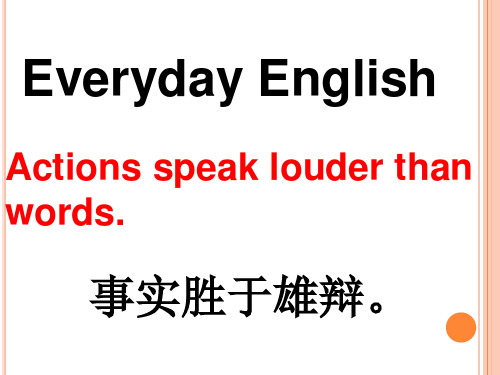
Xiaohui is a Chinese student.
3个冠词
a,an是不定冠词,一个,用于: 可数名词单数前面 用在短文中第一次出现的名词之前
[a用在普通名词前面,an用于元音音素 (元音发音的单词)前面]
a pen /an apple /an umbrella /an egg /an hour /
4. I can’t see the stars in the dark sky.
[Ɔ]
闭音节中的O job clock long song shop stop lost got boss hot a 发[ɔ]的 watch water
句子中的音标
1. She lost that job, but she got this job.
the是定冠词,表示特指
The man is my teacher.
宾格代词顺口溜: 我是me,你是You ; 男他him ,女她her ,动物的它是It; 我们us ,你们You ,他们them.
音标
[ɑ:]
ar car hard star park farm dark party start
meet [mi:t] v.遇见
同音词meat
非正式问候 ---Nice to meet you. --- Nice to meet you, too. 正式问候 --- How do you do? --- How do you do?
too [tu:] adv. 也
用在肯定句和疑问句中,否定句 中用either。 too 和either’ 一般放在句末,并 用逗号隔开。 请用too分别造肯定句和疑问句 Jacky is not a bad student. Rain is not a bad student, either.
新概念英语第一册(Lesson5)课文及学习笔记-全
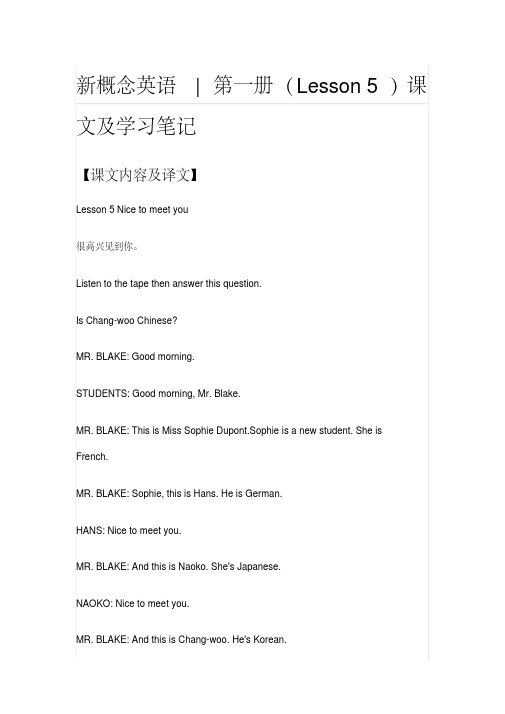
新概念英语| 第一册(Lesson 5)课文及学习笔记【课文内容及译文】Lesson 5 Nice to meet you很高兴见到你。
Listen to the tape then answer this question.Is Chang-woo Chinese?MR. BLAKE: Good morning.STUDENTS: Good morning, Mr. Blake.MR. BLAKE: This is Miss Sophie Dupont.Sophie is a new student. She is French.MR. BLAKE: Sophie, this is Hans. He is German.HANS: Nice to meet you.MR. BLAKE: And this is Naoko. She's Japanese.NAOKO: Nice to meet you.MR. BLAKE: And this is Chang-woo. He's Korean.CHANG-WOO: Nice to meet you.MR. BLAKE: And this is Luming. He is Chinese. LUMNG: Nice to meet you.MR. BLAKE: And this is Xiaohui. She's Chinese, too. XIAOHUI: Nice to meet you.布莱克先生:早上好。
学生:早上好,布莱克先生。
布莱克先生:这位是索菲娅.杜邦小姐。
索菲娅是个新学生。
她是法国人。
布莱克先生:索菲娅,这位是汉斯。
他是德国人。
汉斯:很高兴见到你。
布莱克先生:这位是直子。
她是日本人。
直子:很高兴见到你。
布莱克先生:这位是昌宇。
他是韩国人。
昌宇:很高兴见到你。
布莱克先生:这位是鲁明。
他是中国人。
鲁明:很高兴见到你。
新概念英语第一册 第5-6课 NCE Lesson 5-6

What make is it? It’s a Mercedes. It’s a German car.
What make is it? It’s a Toyota. It’s a Japanese car.
What make is it? It’s a Daewoo. It’s a Korean car.
Lesson 5 Nice to meet you
很高兴见到你
Review
•这是我的...... Here's my...
•这个不是我的...... This is not my...
•号码的表达方法 Number...
Words Review
• umbrella • please • here • ticket • number • sorry • sir
Sophie is a new _s_tu_d_e_n_t_ . _S_h_e__is French
Sophie , This is Hans . He is German.
Nice to meet you .
And __th_is__is__Naoko.
She is Japanese. “_N_ic_e__to__m_e_e_t_y_o_u_ .”
And this is Chang-woo.
He’s _K__o_re_a_n__. “N_i_c_e_t_o_m__e_e_t _y_o_u.”
And this is Luming.
He’s _C_h_i_n_e_s_e__ .
“Nice to meet you .”
And this is Xiaohui .
How many students are there?
新概念英语第一册5-6课(第三课时)

you 主格 你
you 宾格
“你”的主格、宾格形式一样
he
主格
他 him 宾格
she 主格 她
her 宾格
it
主格
它
it
宾格
“它”的主格、宾格形式一样
我们
we 主格 us 宾格
你们
you 主格 you 宾格
“你们”的主格、宾格形式一样
他们
they them
主格 宾格
Nice to meet you . 很高兴见到你(们).
这是非正式场合下初次见面时的客套用语, 回答也应为: Nice to meet you, too.
我也很高兴见到你。 在正式场合中用 How do you do ?您好!
too 也
too adv. 也
用法: 用于肯定句或疑问句尾, 表示“也” too一般都放在句尾, 并且用逗号隔开. I am Chinese, too. 我也是中国人。
人称代词
单 人称
主格
宾格
我
数你
他 她 它
I
me
you
you
he
him
she
her
it
it
人称代词
复
人称
主格
宾格
数
你们
you
you
我们
we
us
他们
they
them
练习
我喜欢你。 他喜欢你。 她喜欢你。 它喜欢你。 我们喜欢你。 他们喜欢你。
I like you. He like you. She like you. It like you. We like you. They like you.
- 1、下载文档前请自行甄别文档内容的完整性,平台不提供额外的编辑、内容补充、找答案等附加服务。
- 2、"仅部分预览"的文档,不可在线预览部分如存在完整性等问题,可反馈申请退款(可完整预览的文档不适用该条件!)。
- 3、如文档侵犯您的权益,请联系客服反馈,我们会尽快为您处理(人工客服工作时间:9:00-18:30)。
Nice to meet you.
复习 • 这是我的...... Here's my... • 这个不是我的...... This is not my... • 号码的表达方法 Number...
上一节课的单词
• • • • • • • • umbrella n. please int. Here adv. ticket n. number n. sorry adj sir n. cloakroom n. • • • • • • • • 伞 请 这里 票 号码 对不起的 先生 衣帽间
Can you tell me the story? Try you best!
三. Text Appreciation:
Good morning !
Good morning , Mr. Blake .
This is Miss Sophie Dupont .
student . Sophie is a new _______
我是哪国人?
• 在说自己是哪一个国家的人时,使用句型: I’m...... 例如:I'm Chinese. • 用以下单词来做一个替换练习吧! French,German,Japanese,Korean, Italian,American,Swedish,English
Nice to meet you!
• 特殊疑问词 Who谁 Whose谁的 Why为什么 When什么时候 Where在哪里 Which哪一个 What什么 What time什么时间 What color什么颜色 How怎么样 How many多少{数量} How much多少钱{价格},(对不可数名词进行提问) How long多长 How often多少次 How big多大 How heavy多重{重量} How far多远{路程}
• •
this is And _______Naoko. She is Japanese. to meet you .” “Nice ______________
And this is Chang-woo. Korean He’s ________. to meet you” “ Nice _____________-.
巧记经典歌诀 妙学特殊疑问句 疑问词走前面,后面跟的是一般; be 动词要提前,情(态)、助动词也赶先; 行为动词请不动,do 和does加在前; does 加在主语前,谓语动词变原形。 说明: ◆一、二句的意思是:特殊疑问词像排头兵,总是走在队伍的最前 面,其后再跟一个一般疑问句。 ◆三、四句的意思是:如果陈述句中谓语部分含有be 动词(is, am, are)、情态动词(can, may, must …),或助动词变为疑问句时, 就一定要把这个词提到主语前面去。 ◆五、六句的意思是:如果谓语部分只有行为动词,那么这个行为 动词不能提前,怎么办?根据需要在主语前、疑问词后加助动词 do(does)。
New words and expressions (2)About cars关于汽车品牌
瑞典的
法国的
德国的 日本的
韩国的
英国的
美国的 意大利的
如何询问汽车的品牌呢?
• What make is the car ? • It’s a German car . • What make is his / her / your car ? • It’s an American car .
三、注意 1.回答特殊疑问句时,不能用yes / no,即问什 么答什么,尤其是简略回答。如: 1) Who is from Canada﹖ Helen (is). 2) Where‘s the restaurant﹖ Near the station. 3) Why do you like koalas﹖ Because they are cute. 2.特殊疑问句一般读降调(↓)。
巧记疑问词 问人用who,问物用what,问时间用 when/what time,问地点用where,问方式用 how 由how引申出五个疑问词:how long持续一 段时间 ;how far问距离; how many问数 量; how much问金钱;how old问年龄。
特殊疑问句
一. 定义 以特殊疑问词开头,对陈述句中的某一部分 提出疑问 / 进行发问的句子叫特殊疑问句。 常用的疑问词有:what 、who 、whose 、 which 、when 、where 、how 、why等。
• 二、特殊疑问句有两种语序 • 1.如疑问词作主语或主语的定语,即对主语或主语的 定语提问,其语序是陈述句的语序:疑问词(+主语)+谓 语动词+其他成分。如: Who is singing in the room﹖ whose bike is broken﹖ 2.如疑问词作其他成分,即对其他成分提问,其语 序是:疑问词+一般疑问句语序? • 如: What class are you in﹖ What does she look like﹖ Where are you from﹖ What time does he get up every morning﹖ How do you know﹖
练一练
1. Excuse B ____ ! Is this your hamdbag? A. you B. me C. it D. I 2. --Is this your umbrella? -- No, it D ____ . A. is B. not is C. my D. isn’t A 3. – What is your name? –Pardon? --_____ A. What is your name? B. Is this your hamdbag? C. Thank you very much! D. Nice to meet you.
知识点复习
• Mr. 先生
Mr.用于男士的姓之前,不能单独使用,如课文 中的 Mr.Blake;而sir 一般单独使用,是对长者、 上司或男顾客的尊称,如:Sorry, sir. 对不起, 先生。
• Miss 小姐 一般用于指未婚女子,不过有时在不知道 对方是否已婚时也可使用
不定冠词
• 冠词数量上表示“一个”。冠词一共有 三个,分为不定冠词(a,an)和定冠 词(the)。 • 可数名词单数前面必须要用不定冠词。 a用在以辅音音素开头的名词前面 an 用于以元音开头的名词前面 例如:a pen an apple an umbrella an egg an hour a shirt
一. Listen to the tape ,then answer this question “Is Chang-woo Chinese?”
如何询问国籍呢?
• • • • • What nationality is she /he ? She’s French/Chinese/German/Korean He’s …. What is your nationality ? I am American / Italian / English .
And this is Luming. Chinese . He’s _________
“Nice to meet you .”
And this is Xiaohui . She’s Chinese , ______.
“Nice to meet you .”
too
课文讲解
• Good morning. 早上好 那么下午好和晚上好还记得怎么说吗? Good afternoon. Good evening. 再见 good bye 晚安 good night 祝你好运 good luck
单词复习
• • • • • • Mr. Miss good adj. morning n. new adj. student n. 先生 小姐 好 早晨 新的 学生
New words and expressions (1)About nationality 关于国籍 • French adj.&n. 法国的;法国人 • German adj.&n. 德国的;德国人 • nice adj. 美好的 • meet v. 遇见 • Japanese adj.&n. 日本的;日本人 • Korean adj.&n. 韩国的;韩国人 • Chinese adj&n. 中国的;中国人 • too adv. 也
人们在正式的场合初次见面时常用: How do you do? 相应的回答也是:How do you do? 这是一句问候语,并非问话。
nice
• ① adj. 美好的,好看的 It’s a nice day today, isn’t it? That's a nice shirt. ② adj. 和蔼的,友好的 He is very nice to his neighbours. ③ adj. 使人高兴的,令人愉快的 It is so nice to have you here.
ห้องสมุดไป่ตู้
Chinese 中国的;中国人
National flag 国旗
French 法国的;法国人
German 德国的;德国人
Japanese 日本的;日本人
Korean 韩国的,韩国人
Swedish
瑞典的;瑞典人
English 英国的;英国人
American 美国的;美国人
Italian 意大利的;意大利人
She _____is French
Sophie , This is Hans . He is German.
见到你很高兴!
Nice to meet you .
Nice to meet you. meet 遇见 很高兴见到你。
